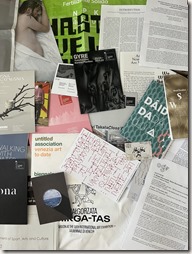
By now, if you are interested in the 59th Venice Biennale, you probably have read articles from well-known art “experts” at various media outlets. I have my favorites, don’t get me wrong. I have read the same articles and agree with a lot that has been said. But for me personally, this year was so much different than in 2019! I am not talking current world events that naturally weave their narrative into contemporary art. I am talking about having experienced the Biennale once before, I could never look at Venice or the Biennale the same way again. I spent much more of my time looking for and at art, than I did the first time. How could I not get wrapped up being in Venice for the first time? This time, getting lost in Venice was no big deal, I felt very comfortable wandering around. This year, I was able to see the trees instead of just the forest.
We changed the way we sought out and experienced art this time. Last time we saw all the big exhibitions at the national pavilions but stumbled upon our favorite exhibitions by accident. This time we purposely looked for those small venues: small spaces, unknown artists. Our hunts for the unknown failed a couple of times: we looked for an Ai Weiwei piece that it turned out was not going to be installed till July.
The Biennale is officially broken into two parts but there are three in reality. There is the Giardini where all the large counties have permanent pavilions. Then there is the Arsenale which houses the themed exhibitions of the biennial; this year it was “Milk of Dreams”. Also, smaller countries have space there for their national pavilions. The third, unofficial part is the ancillary art that happens in vacant spaces around Venice - popup galleries of all shapes and sizes. They may have a line or two in the program and a sign in front of their space. I am going to focus on three off-the-grid spaces.
My favorite accidental art experience was the Edge’s first-ever aerial drone performance “Social Sacrifice.” It explored the swarming dynamics exhibited by a school of fish encountering a predator, the work highlights the tensions that emerge between collective action and individual freedom, as well as how these change in the presence of external threats (so Julia Kagensky says on their website aorist.art). How could we not go see it? There were 15-20 drones that because of the darkness in this huge old building, you could only hear a swarm of angry hornets over your head, until their individual white light came on. That is when the fun really began. In tune with the sweeping music which was playing, the drones washed from side to side of the building in an amazing feat of technology, with none of them came crashing down. Then a single red light flashed on and the school of drones starts to panic and try to get away from the red light. A completely mesmerizing experience. My words do not do the experience justice. Here’s a video of the experience: https://youtu.be/uuM0bhdaNmQ
We were guided to my next find by our flat mates. “Where Once the Waters” by David Cass used small discarded tin containers to have a conversation about global warming. On one wall were 365 small discarded tins with a seascape painted on their fronts. The opposite wall was covered with 600 typed letters; each from a witness to sea level rise from all over the world. The conversation between the two opposing walls could not have been louder. (have pictures).
My third and most bizarre art event was a performance put on by the Republic of Kazakhstan, “LAI-PI-CHU-PLEE-LAPA. Centre for the new genius”. If you had read in the catalog or any of the other guides; you would not have expected this. Kazakhstan is in Central Asia and the contents of their pavilion was supposed to travel through Ukraine. Obviously, with the Russian invasion of Ukraine, the art did not arrive in time to be installed before the press preview. What we walked into looked more like a very bad backdrop for an homemade sci-fi movie. I can not give this group of young artists more praise for what they came up with, nothing but a bare space to start with.
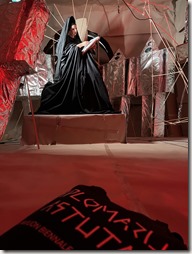
Thousands of miles from home, only using locally sourced materials to recreate their national pavilion in seven days. We walked in through a drapery of aluminum foil covering the door way. Once inside we were given a large sheet of heavy gaged gray paper to use as a cloak and a crumpled-up ball of aluminum taped to the top of my cap. We were then led into the temple of the “New Genius”, also completely made out of aluminum foil held together with a lot of scotch tape. The dozen or so of us sat on the floor facing a woman all dressed in black needlepoint. On either side of her were 2 life size cardboard robots also covered in aluminum foil. Then the performance began. Needless to say, another highlight of the unexpected.
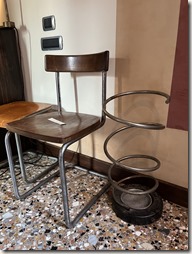
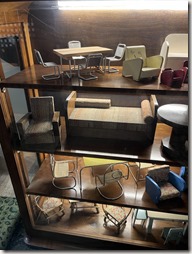
In a footnote. I love mid-century-modern furniture; Eames, Nelson, etc. On our way to the Kazakhstan pavilion, we stumbled into the most amazing furniture exhibition I have ever seen. On the first three floors of the Ca’ Pisani Design Hotel was an exhibition of furniture designed in Italy 1928-49. Truly a once in a lifetime experience. This was the first time the Freak Andò Antiquariato Modernariato Design had shown this much of its collection publicly. Needless to say, I wanted to take most of the exhibit back home. Unfortunately, all I got away with were photos of a bentwood frame bicycle, doll house furniture and a very cool umbrella stand.
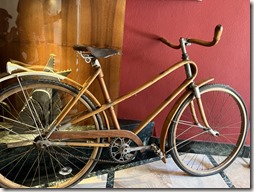
To end with, yes, it was very difficult to not see this whole biennale through Ukrainian colored lenses. Their pavilion was very difficult to experience. The contents of the first floor had been produced as the war raged in their country. Letters written every day since the first day of the invasion, with more added each day. Supersized paintings of volunteers fighting in the war as we looked at them. It was even more disturbing in person.
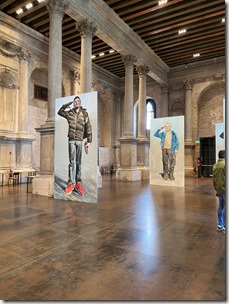
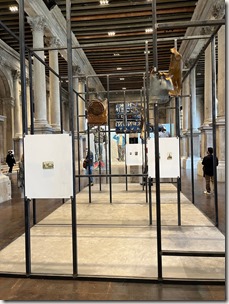
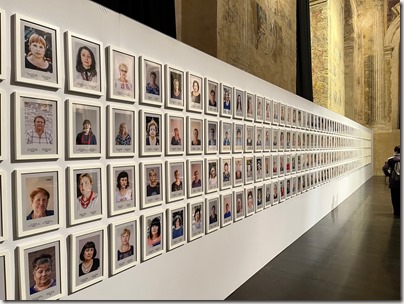
I look forward to experiencing all the fun and madness that make up the Venice Biennale again in two years. I expect amazing art and at the same time having no idea what we will stumble across.